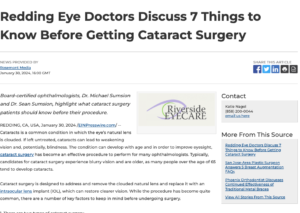Redding Eye Doctors Discuss 7 Things to Know Before Getting Cataract Surgery
 Board-certified ophthalmologists, Dr. Michael Sumsion and Dr. Sean Sumsion, highlight what cataract surgery patients should know before their procedure.
Board-certified ophthalmologists, Dr. Michael Sumsion and Dr. Sean Sumsion, highlight what cataract surgery patients should know before their procedure.
Redding, CA – Cataracts is a common condition in which the eye’s natural lens is clouded. If left untreated, cataracts can lead to weakening vision and, potentially, blindness. The condition can develop with age and in order to improve eyesight, cataract surgery has become an effective procedure to perform for many ophthalmologists. Typically, candidates for cataract surgery experience blurry vision and are older, as many people over the age of 65 tend to develop cataracts.
Cataract surgery is designed to address and remove the clouded natural lens and replace it with an intraocular lens implant (IOL), which can restore clearer vision. While the procedure has become quite common, there are a number of key factors to keep in mind before undergoing surgery.
1. There are two types of cataract surgery.
The two general types of cataract surgery are traditional cataract surgery and laser cataract surgery. Traditional cataract surgery is considered a more routine procedure, wherein a thin and specialized blade is utilized to create a precise incision. Then, an ultrasonic instrument breaks up the clouded lens. On the other hand, laser cataract surgery uses laser technology to create the necessary incisions to then break up the cataract.
2. There are a variety of ways to prepare for cataract surgery.
Before surgery, patients are provided comprehensive pre-procedure instructions. Typical instructions include stopping certain medications, completing an ultrasound test, using prescribed antibiotic eye drops, and avoiding eating and drinking for about 12 hours in advance.
3. There are multiple cataract surgery lens options.
Cataract surgery involves the natural eye lens being replaced with an IOL. The type and degree of vision correction needed can determine which IOL is selected. Options include:
- Monofocal Lenses – Traditional lenses that correct for long distance vision
- Multifocal Lenses – Advanced lenses that improve vision at all distances
- Toric Lenses – Ideal for correcting astigmatism
- TECNIS® Symfony Extended Range of Vision IOL – State-of-the-art lenses that combine the clarity of monofocal lenses with the range of multifocal lenses
4. Cataract surgery usually takes about 15-20 minutes per eye.
Performed as an outpatient procedure, the cataract surgery process usually starts with a topical anesthetic applied to the eyes to reduce potential discomfort. A mild sedative can also be used if desired. A small incision is made in the front of the eye, then the cataract and the eye’s natural lens are removed. An IOL is finally inserted to replace the original lens. The natural pressure of the eye typically seals the incision without need for sutures. Cataract surgery is performed one eye at a time, with one eye treated typically two weeks after the first to ensure healing time. The surgery can be completed in about 15-20 minutes.
5. Like most surgeries, there are potential side effects associated with cataract surgery.
There are a few potential and common side effects, including temporary redness and irritation. Some patients may notice mild bruising underneath the eyes and blurriness during the healing process. Side effects usually subside quickly.
6. Recovery from cataract surgery is typically minimal.
The recovery process and time can vary from patient to patient, but most can return home on the same day as their procedure. Many patients return to their normal routines after a couple of days. Aftercare instructions usually include wearing protective eyewear at night, using prescription eye drops, and post-op visits to ensure successful healing.
7. IOLs implanted during cataract surgery are expected to last a lifetime.
Cataract surgery has been known to greatly improve vision clarity, and thus, enhance a patient’s quality of life. IOLs are expected to be long-lasting and rarely need to be replaced.
About Michael Sumsion, MD
Dr. Michael Sumsion, a board-certified ophthalmologist, attended the University of Utah Medical School and performed his Ophthalmology residency at the renowned Mayo Clinic. He specializes in cataract surgery and LASIK surgery, and is highly experienced in performing both procedures. He is a member of the American Society of Cataract and Refractive Surgery, the American Medical Association, the American Academy of Ophthalmology, and the California Academy of Eye Physicians and Surgeons. Dr. Sumsion has served the Redding community for over 20 years and is committed to providing patients with the latest and most effective eye care solutions.
About Sean Sumsion, MD
Dr. Sean Sumsion was previously a Resident Physician and Associate Clinical Professor at the University of Texas Health Science Center. While there, he contributed to and authored five peer-reviewed articles and received the Resident of the Year Award in June 2016. He is a board-certified ophthalmologist who prides himself on providing comprehensive eye care services to his patients.
Dr. Michael Sumsion and Dr. Sean Sumsion are available for interview upon request.
For more information, visit recp-eyemd.com and facebook.com/RiversideEyeCareProfessionals.
Contact:
Riverside EyeCare Professionals
2801 Park Marina Dr.
Redding, CA 96001
(530) 244-2273
Rosemont Media
(858) 200-0044
www.rosemontmedia.com